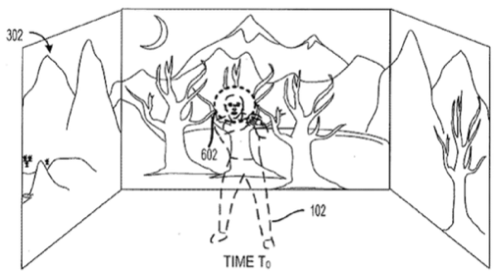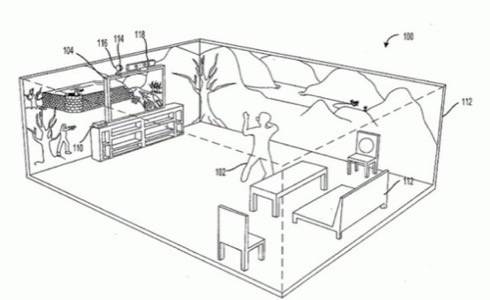
Microsoft took a step toward creating – and owning – the Star Trek holodeck this week via a patent application that introduces the concept of a “peripheral display” that can project game scenes onto the walls, ceiling and floors of a room.
The idea, according to patent application number 20120223885, is to improve the realism of the display, so that the player is immerse more thoroughly in the game world.
Right Out Of Star Trek
That’s not too far away from the holodeck concept introduced in Encounter at Farpoint, the premiere episode of Star Trek: Next Generation where the crew members enjoy simulated experiences in a room where holographic projections layered on extruded force fields and replicated matter give the illusion of reality. (OK, maybe it israther far away, but one step at a time.)
Microsoft already has produced one of the most immersive peripherals for a video game: Kinect, whose infrared “eyes” can detect a user’s skeleton, face and voice, recognizing him and placing him in a virtual world. Players can interact with virtual objects by kicking, punching, or grabbing them – although such interactions must by necessity take place within the two-dimensional frame of the TV screen.
What Microsoft’s patent application proposes is a way to reduce the awareness that you’re sitting in front of that screen:
Even when focused on the display, the user may perceive architectural and decorative features of the room the display is in via the user’s peripheral vision. Such features are typically out of context with respect to the displayed image, muting the entertainment potential of the media experience. Further, because some entertainment experiences engage the user’s situational awareness (e.g., in experiences like the video game scenario described above), the ability to perceive motion and identify objects in the peripheral environment (i.e., in a region outside of the high resolution display) may intensify the entertainment experience.”

What the patent application offers is the ability to go beyond that limitation, projecting “peripheral” images onto the walls, ceiling and floor of a player’s living room. The application suggests that the “depth camera” (the existing camera used by a Kinect or some next-generation device) could be placed next to an “environmental display” projector, so that the same unit could project images around the user. More sophisticated setups could use more than one RGP projector. Instead of “surround sound,” think of a “surround display.”
Next Step? 3D!
Microsoft even goes so far as to suggest that a properly placed arrangement of cameras could enable 3D “wiggle” stereoscopic images on the walls, improving the experience even further. The patent application also mentions that the projected images would account for the angles of the walls and other scenery – a feat that Intel accomplished in real life this week, and with a Kinect, to boot.
As for a controller – who needs it? An improved Kinect-like device could also be used to track the player’s eyes or face, letting those serve as controls, the patent suggests.
Of Course There’s A Catch
Of course, there are a significant number of issues Microsoft doesn’t really account for, such as the number of projectors needed to create an actual image. Players may not be able to tromp through the living room hunting space aliens without tripping over a coffee table or couch. (But imagine the hilarity of a game that superimposed a virtual Covenant Hunter over your wedding photo!)
There might also be problems with orientation; the patent application suggests that players could turn around and see a virtual enemy sneaking up behind them. If a game player was able to orient himself independently, he or she would end up interacting primarily with the display projected on the walls, not the HDTV. To think of this another way: if the HDTV always represented the north-facing view in the game, any time the player wanted to run south, or east, he or she would be facing the wall. And if the game rotated back to accommodate the player movement, there would really be no way to interact with an enemy behind you.
Still, we can’t help but be excited about any progress toward creating the much-loved Holodeck.





















